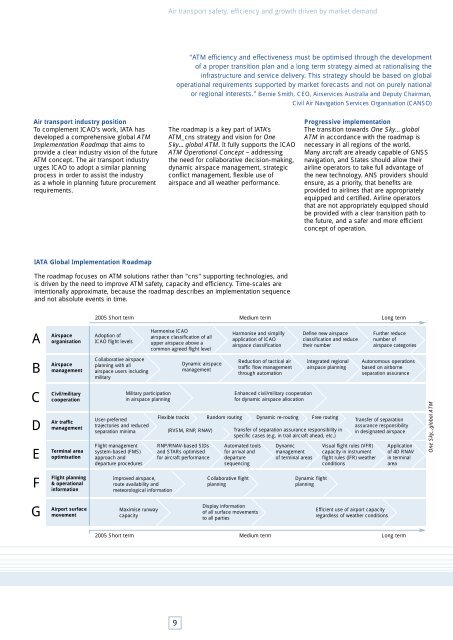ATAG Corporate brochure
ATAG Corporate brochure
ATAG Corporate brochure
You also want an ePaper? Increase the reach of your titles
YUMPU automatically turns print PDFs into web optimized ePapers that Google loves.
Air transport industry position<br />
To complement ICAO’s work, IATA has<br />
developed a comprehensive global ATM<br />
Implementation Roadmap that aims to<br />
provide a clear industry vision of the future<br />
ATM concept. The air transport industry<br />
urges ICAO to adopt a similar planning<br />
process in order to assist the industry<br />
as a whole in planning future procurement<br />
requirements.<br />
IATA Global Implementation Roadmap<br />
Air transport safety, efficiency and growth driven by market demand<br />
"ATM efficiency and effectiveness must be optimised through the development<br />
of a proper transition plan and a long term strategy aimed at rationalising the<br />
infrastructure and service delivery. This strategy should be based on global<br />
operational requirements supported by market forecasts and not on purely national<br />
or regional interests." Bernie Smith, CEO, Airservices Australia and Deputy Chairman,<br />
Civil Air Navigation Services Organisation (CANSO)<br />
The roadmap is a key part of IATA’s<br />
ATM_cns strategy and vision for One<br />
Sky…global ATM. It fully supports the ICAO<br />
ATM Operational Concept – addressing<br />
the need for collaborative decision-making,<br />
dynamic airspace management, strategic<br />
conflict management, flexible use of<br />
airspace and all weather performance.<br />
The roadmap focuses on ATM solutions rather than "cns" supporting technologies, and<br />
is driven by the need to improve ATM safety, capacity and efficiency. Time-scales are<br />
intentionally approximate, because the roadmap describes an implementation sequence<br />
and not absolute events in time.<br />
A<br />
B<br />
C<br />
D<br />
E<br />
F<br />
G<br />
Airspace<br />
organisation<br />
Airspace<br />
management<br />
Civil/military<br />
cooperation<br />
Air traffic<br />
management<br />
Terminal area<br />
optimisation<br />
Flight planning<br />
& operational<br />
information<br />
Airport surface<br />
movement<br />
2005 Short term Medium term Long term<br />
Adoption of<br />
ICAO flight levels<br />
Collaborative airspace<br />
planning with all<br />
airspace users including<br />
military<br />
Flight management<br />
system-based (FMS)<br />
approach and<br />
departure procedures<br />
Military participation<br />
in airspace planning<br />
User-preferred<br />
trajectories and reduced<br />
separation minima<br />
Harmonise ICAO<br />
airspace classification of all<br />
upper airspace above a<br />
common agreed flight level<br />
Flexible tracks<br />
Improved airspace,<br />
route availability and<br />
meteorological information<br />
Maximise runway<br />
capacity<br />
RNP/RNAV-based SIDs<br />
and STARs optimised<br />
for aircraft performance<br />
2005 Short term Medium term Long term<br />
9<br />
Dynamic airspace<br />
management<br />
(RVSM, RNP, RNAV)<br />
Harmonise and simplify<br />
application of ICAO<br />
airspace classification<br />
Reduction of tactical air<br />
traffic flow management<br />
through automation<br />
Enhanced civil/military cooperation<br />
for dynamic airspace allocation<br />
Automated tools<br />
for arrival and<br />
departure<br />
sequencing<br />
Dynamic<br />
management<br />
of terminal areas<br />
Progressive implementation<br />
The transition towards One Sky…global<br />
ATM in accordance with the roadmap is<br />
necessary in all regions of the world.<br />
Many aircraft are already capable of GNSS<br />
navigation, and States should allow their<br />
airline operators to take full advantage of<br />
the new technology. ANS providers should<br />
ensure, as a priority, that benefits are<br />
provided to airlines that are appropriately<br />
equipped and certified. Airline operators<br />
that are not appropriately equipped should<br />
be provided with a clear transition path to<br />
the future, and a safer and more efficient<br />
concept of operation.<br />
Define new airspace<br />
classification and reduce<br />
their number<br />
Integrated regional<br />
airspace planning<br />
Random routing Dynamic re-routing Free routing<br />
Collaborative flight<br />
planning<br />
Display information<br />
of all surface movements<br />
to all parties<br />
Transfer of separation assurance responsibility in<br />
specific cases (e.g. in trail aircraft ahead, etc.)<br />
Dynamic flight<br />
planning<br />
Visual flight rules (VFR)<br />
capacity in instrument<br />
flight rules (IFR) weather<br />
conditions<br />
Further reduce<br />
number of<br />
airspace categories<br />
Autonomous operations<br />
based on airborne<br />
separation assurance<br />
Transfer of separation<br />
assurance responsibility<br />
in designated airspace<br />
Efficient use of airport capacity<br />
regardless of weather conditions<br />
Application<br />
of 4D RNAV<br />
in terminal<br />
area<br />
One Sky...global ATM

















